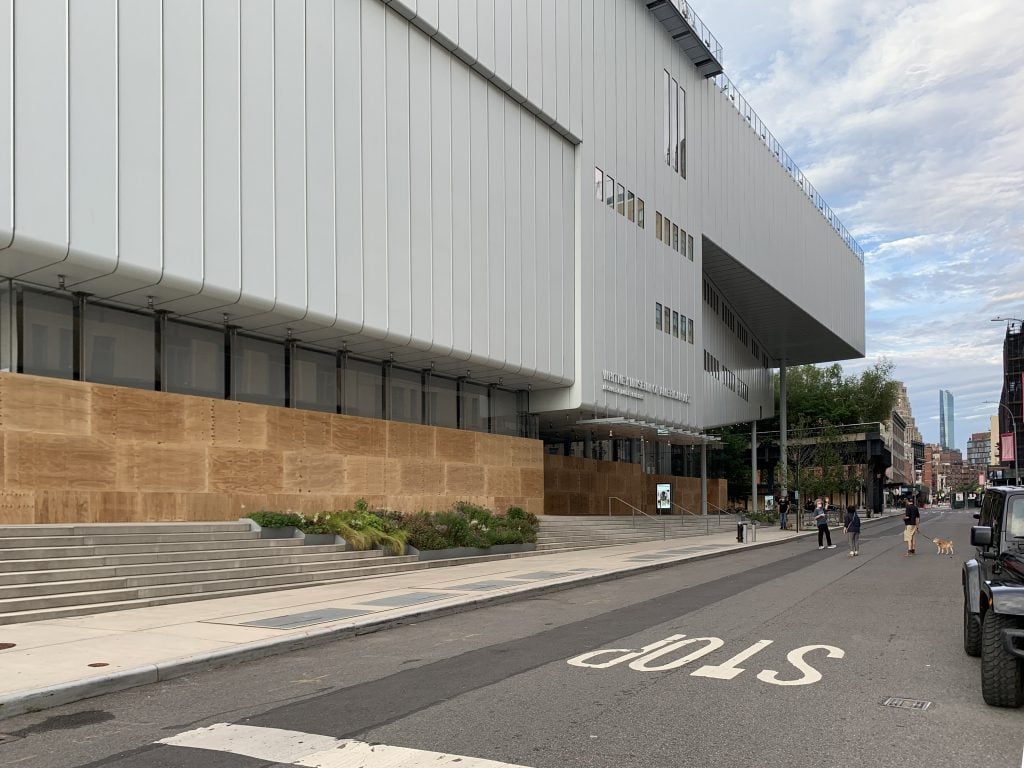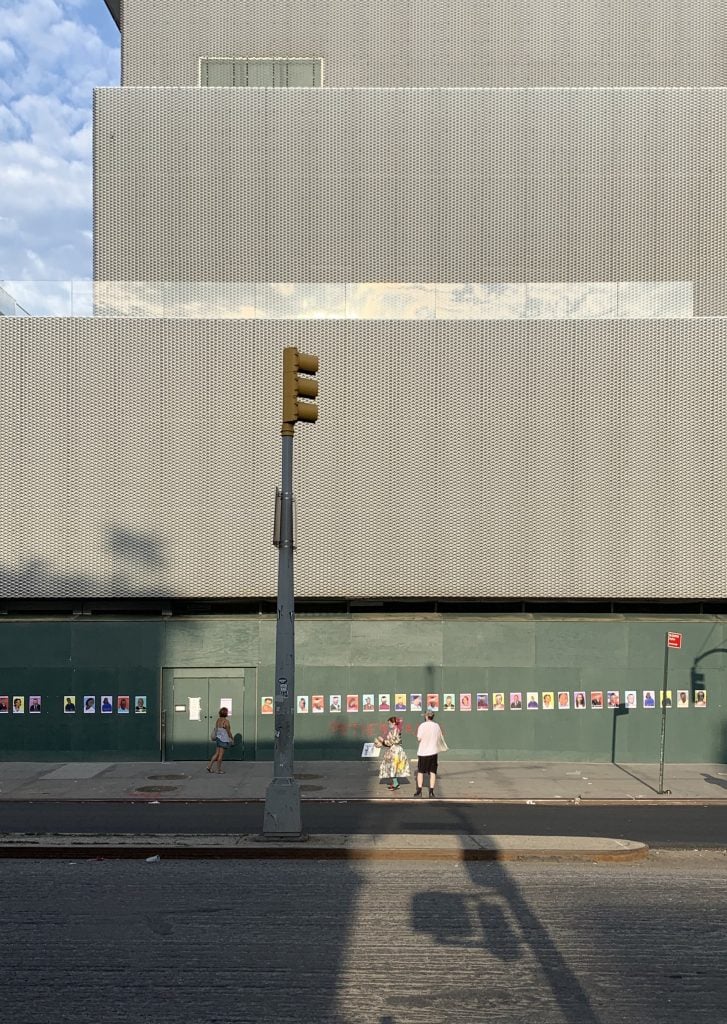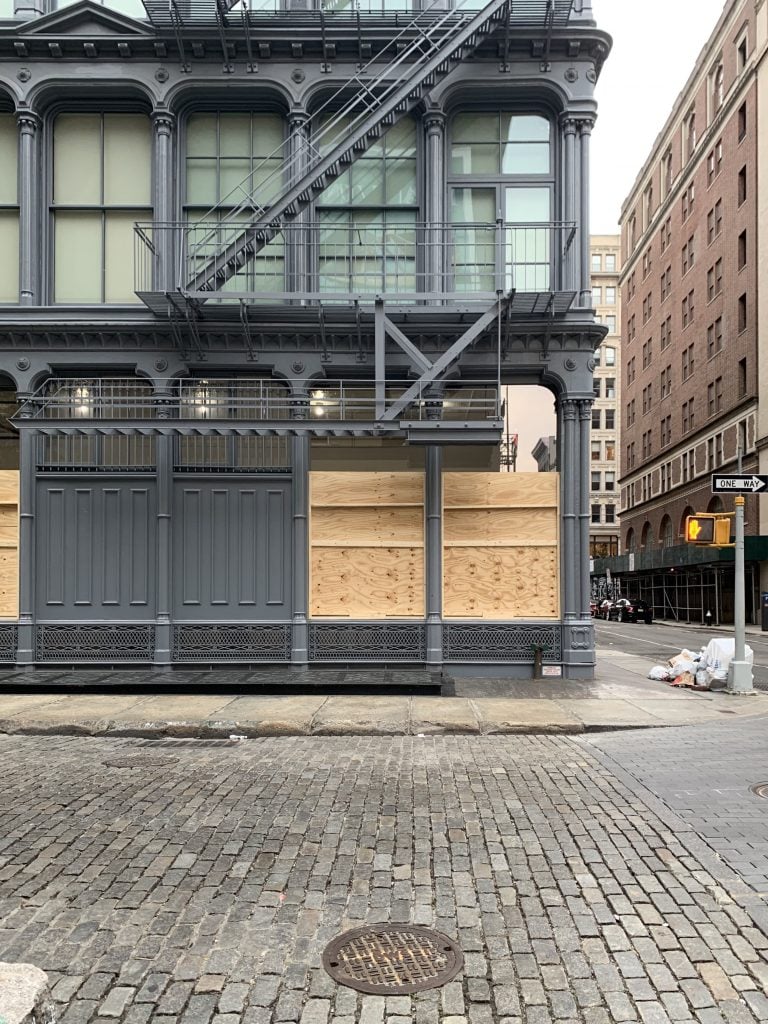Amid the stream of information about systemic racism and demands for societal change filling my Instagram feed, a recent series of posts by my friend Lucie Rebeyrol stood out. She shared images of the glass-enclosed lobbies of three leading New York City museums—the Museum of Modern Art, the Whitney Museum of American Art, and the New Museum—hermetically boarded up with countless sheets of plywood.
While many New York theaters responded to calls to #openyourlobbies by doing just that, offering essential support for demonstrators during Black Lives Matter protests, few museums followed suit. To my knowledge, only the Brooklyn Museum and Artists Space made an honest effort to invite protesters in, while MoMA PS1 distributed water and snacks in front of its building.
Why did most of New York’s largest museums botch this chance to connect to a younger audience—one that has grown distrustful of their boards, labor practices, executive salaries, and even the art on their walls? Were they too impaired by the prolonged shutdown and associated financial hardship? Or could the lobbies themselves not offer adequate support in these extraordinary times?

The Museum of Modern Art. Photo: Lucie Rebeyrol.
Museum architects—I am one of them—love to talk about openness. We celebrate the “productive friction” that might occur between the institutional space and the city beyond. A go-to solution for maximizing this exchange is the glazed (glassed-in) storefront, which is designed to invite the public into the visible lobby beyond, a space often described metaphorically as a forum, plaza, or living room.
But while these spaces were originally designed to invite people in, they have increasingly served to keep some people out, telegraphing that the pristine space behind the glass is not for them. The plywood many museums have covered themselves in right now is, in fact, not the opposite of the glass—it is an extension of it.
To understand how lobbies became such a container of contradictions, let us consider the history of those three boarded-up New York museums.
Right before the pandemic hit New York, MoMA reopened with a completely rethought ground floor. One of its architects, Liz Diller of Diller Scofidio + Renfro, described the logic of the space in a press statement as “a contiguous, free public realm that bridges street to street and art to city.” The glass facade DS+R designed, which faces 53rd Street, “invites a more open dialogue between interior and exterior spaces,” Diller said. It also builds on the storied history MoMA has with this minimal edge and Modernist architecture as a whole.

The entrance to MoMA. Photo: Lucie Rebeyrol.
The father of Modernist architecture, Philip Johnson—whose own legacy has been reevaluated in recent years due to his documented interest in Nazism—founded and ruled MoMA’s architecture department for decades. Johnson championed no architect more than Mies van der Rohe, the godfather of the glass facade, whose fully glazed Neue National Gallery (completed in 1968) in a liberated West Berlin marked a paradigm shift in museum design. Its transparency was thought to represent an open and democratic relationship between art and a new universal citizen.
Five years later, a Johnson-led jury brought Renzo Piano, alongside Richard Rogers, to worldwide fame when it awarded the young architects the Centre Pompidou commission in the center of Paris. By creating an open plaza and a full transparent facade, Piano pulled the city square quite literally into the museum lobby, a move he has been trying to emulate ever since. When he revealed the design for the new Whitney Museum in 2011, Piano remarked: “The first big gesture, then, is the cantilevered entrance, which transforms the area outside the building into a large, sheltered public space.” This public space then naturally flows into the glass-enclosed lobby, complete with a Danny Meyer restaurant and a store full of tchotchkes.

The Whitney Museum. Photo: Lucie Rebeyrol.
The New Museum, founded by Marcia Tucker, a radically progressive Whitney renegade, has its own notorious history with glazed storefronts. While located in SoHo (from 1979 to 2004), the museum’s “Window on Broadway” program exhibited site-specific work in its street-level windows. This free offering of art was an innovation in museum practice and allowed for critical and polemical messaging in a rapidly gentrifying neighborhood.
The best-known contribution to this series might be the “Silence=Death” neon sign, designed to raise AIDS awareness. But perhaps the most provocative, and relevant today, was Erika Rothenberg’s show “Have You Attacked America Today?” The installation—a critique of America’s political and social agenda, complete with DIY flag-burning kits and a satirically rewritten national anthem—caused such contention in 1989 that decriers smashed the windows with garbage cans three times.
SANAA, the architects of the current New Museum building on the Bowery (where I worked at the time), directly referenced this history when it gave the ground floor a fully transparent façade. Even the loading dock doors are glazed.
So why did these museums—all of which have served as civic, community hubs throughout their histories—board up last week? Has the contrast between the curtain-walled white cube and the variegated street become too harsh? Were its directorates fearful public rage would turn against their institutions; that their precious glass shells would be smashed and the goods inside looted, just like the luxury brands next door?
Modern architects adapted the glass-window wall from factory designs to make art institutions feel less monumental. Yet today, these large panes of glass represent consumerism, while transparency evokes associations with surveillance. The clear storefront that supposedly welcomes the public also allows the institution to project its normative value system onto the city. If museums are to remain relevant within our changing society, their entrances need to be rethought.

The New Museum. Photo: Lucie Rebeyrol.
How could museum lobbies and storefronts be redesigned to draw an audience that is not predominantly white and upper class? An obvious first step would be to bring the public into the design process; architecture is embarrassingly un-diverse. Rather than encountering a sweeping field of stanchions directed towards a solemn “welcome desk” upon entry, one could imagine a variety of spaces offering seating, shelter, and privacy. Guests would be invited to roam around unrestricted. There would be ample water fountains, accessible bathrooms, charging stations; WiFi would be free, secure, and private. Ticketing would be handled mostly digitally and admission offered on a sliding scale, depending on one’s means and needs.
Rather than fancy restaurants and gimmicky stores, lobbies could host outside organizations to convene and organize. The museum might act as a partner and participant, catalyst, and amplifier. Here, there are no bananas stuck to the wall, but ample meaningful information for an active audience. Guards would protect patrons over property. And during the next protest, lobbies could open up and transform into staging grounds, sanctuary spaces, and broadcasting stations for citizen journalists.
For now, as museums figure out their future, I suggest we keep them boarded up. The plywood will attract more radical ideas than marketing firms can imagine. For museums realizing change is imminent, the material could stay up as a construction fence during their makeovers. When the layer eventually comes off, let it keep its marks, tags, and traces. Donate it to organizations, transform it into chairs and tables for public plazas or community gardens, or turn it into shields against police brutality. At least acknowledge the sheets are part of the public domain, as our lobbies once were.
Florian Idenburg is a Brooklyn-based architect who founded SO – IL with Jing Liu. He previously worked as an architect at SANAA on the design of the New Museum building on the Bowery.
Follow Artnet News on Facebook:
Want to stay ahead of the art world? Subscribe to our newsletter to get the breaking news, eye-opening interviews, and incisive critical takes that drive the conversation forward.









